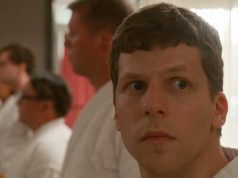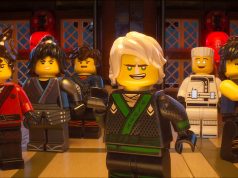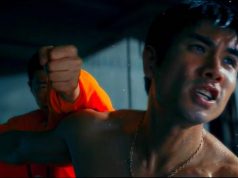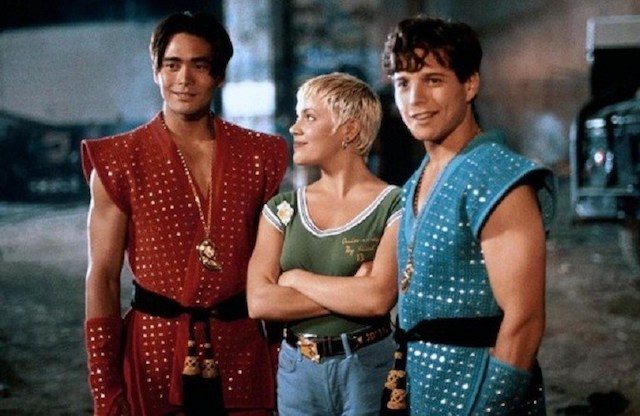
Here’s a good example of how the movie business is an unpredictable crapshoot. On Nov. 4, 1994, an adaptation of the video game Double Dragon was released in theaters. It was terrible, and it only made $2 million. Six weeks later, a movie version of the video game Street Fighter was released. It was also terrible — but it made $100 million. Why did “Street Fighter” earn 50 times as much money as “Double Dragon”? I grant you that “Street Fighter” had Jean-Claude Van Damme in the lead while “Double Dragon” only had the guy from “Party of Five” (which did not even exist yet!), but surely this alone cannot account for the huge disparity in income between these two essentially interchangeable movies. That’s like telling a pair of identical twins that one of them is beautiful and the other one is ugly when in fact they’re both silly, cheap things based on video games.
“Double Dragon” begins with the standard hooey about an ancient Chinese medallion that has mystical powers over the body and soul, it can control everything, yada yada. Listen, buster, we’ve heard it all before. Long ago, the emperor split it in half so that nobody could have all the power at once, and people have been trying to get the two halves together ever since. Everyone calls it “the double dragon,” though I don’t think cutting something in half is the same as doubling it.
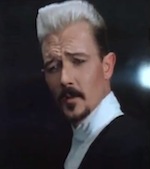
Anyway, the two halves of the medallion (or possibly “two medallions”) have been hidden for centuries when we start the movie, which is set in the futuristic year of 2007. A massive earthquake leveled Los Angeles back in 2000 (remember??), and the ruined city, now called New Angeles, is run by gangs and vigilantes — and sure, make your jokes about how that’s not much different from the real Los Angeles, but please keep in mind that the post-apocalyptic version has more parking and less smog than the real one. A ruthless crime lord and millionaire named Kogo Shuko (Robert Patrick) wants the medallion(s) so that he can rule the world, and he’s already had a foxy minion named Linda Lash (Kristina Wagner) retrieve one half from its ancient hiding place in a remote Chinese village. The movie doesn’t tell us how Linda found an artifact that the movie just finished telling us was unfindable, though. In fact, the movie doesn’t even seem to notice the discrepancy.
Back in New Angeles, Shuko is delighted to have the medallion and eager to find the other half. You can tell Shuko is evil because he has a goatee and the same hairstyle as Vanilla Ice, which only a sociopath would choose on purpose. Little does Shuko know that the other half of the medallion is currently dangling from the neck of someone who lives right here in New Angeles! Locating and obtaining the part that was tucked away in an isolated foreign village was easy. It’s the local half, the one being worn as a necklace, that’s problematic.
The wearer of the half-medallion is Satori (Julia Nickson), a beautiful Chinese-American woman who has the artifact because she happened to be there when it was found by some explorers, who I guess weren’t terribly concerned about what happened to it next. Satori acts as guardian not just to the medallion but to Jimmy and Billy Lee, a pair of twins who are clearly in their 20s and do not need a guardian, unless it’s because they’re juvenile, snickering morons (although if that’s the case there are a lot of guys in their 20s who should have guardians). Jimmy and Billy are played by Mark Dacascos (from previous Bad Movies entry “Only the Strong”) and Scott Wolf (from “Party of Five”). You might think that being of different ethnicities would preclude Dacascos and Wolf from being cast as brothers at all, let alone twins, but you have to remember that the movie takes place in the future and is terrible.
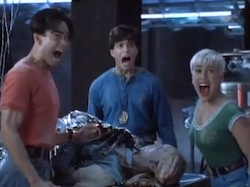
Our first introduction to Jimmy and Billy is at a martial-arts tournament, where they compete as a team and do pretty well, although Billy (the Scott Wolf twin) is not very serious about it. When some opposing fighters taunt them after the match, Billy yells, “Eat the fist, buttheads!” and starts a brawl. (Can you imagine a fight breaking out at a martial-arts tournament? Shameful.) And that’s basically the end of Billy and Jimmy’s fighting prowess as far as the movie is concerned. They spend the rest of the film being pursued by villains and henchmen, and their typical response is to look at each other, do a comical simultaneous scream of terror, and run away. They engage in hand-to-hand combat only after exhausting all the cowardly options, including fleeing and making dumb wisecracks.
The reason I’m telling you so much about Billy and Jimmy is that it turns out they are our main characters. I know, I’m not thrilled about it either, but there you go. One of Shuko’s goons, a Mohawked street punk named Bo Abobo (Nils Allen Stewart), happens to notice Satori’s medallion when he happens to choose Billy and Jimmy to pick on one night — Shuko learns of the medallion’s location completely by accident, in other words — and the chase is on! Having fulfilled her role as Provider of Backstory, Satori gets conveniently killed, leaving the medallion in the sweaty, stooge-like hands of Billy and Jimmy the idiot twins.
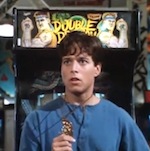
Meanwhile, there’s a group of vigilantes called the Power Corps who are dedicated to taking the streets back from the deadly gangs, something the police have refused to do because it is too hard. (In the one scene where a cop tries to do anything — he fights with Linda Lash — he doesn’t have a gun. Maybe being unarmed is why the police force is reluctant to do police work?) Since the gangs are allied with Shuko, that means the Power Corps are allied with Billy and Jimmy. Their leader is a girl named Marian. She is played by Alyssa Milano, which unfortunately emboldens the movie enough to have someone fight with her and say, “Now who’s the boss??,” which is inexcusable. Also, at one point everyone’s in a room filled with arcade games, and one of the games is Double Dragon, which is just stupid. I mean, come on, movie. Don’t be cute. I know you were intended for 12-year-olds, but you can do better than that.
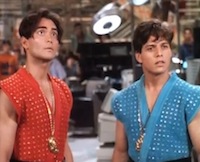
The half of the medallion that Shuko already has gives him the power to occasionally leave his body and possess someone else’s, but only for a couple minutes, and not consistently. The half of the medallion that the twins have does not do anything, or at least not anything that they’re able to figure out. It isn’t until Billy hurls it away in disgust that the medallion comes to life, leading us to conclude that it is activated by the power of frustration, or perhaps by the power of not being held by Billy. When it does work, it gives the guys super strength, kind of, for a minute, and then doesn’t. The powers of the medallion are erratic at best. You can see why Shuko is the first person in centuries to put forth any effort to find it. Not really one of your top-tier magical artifacts. When Jimmy and Billy finally get both halves and put them together, they discover that the medallion has the power to give them matching costumes, which was evidently all they ever wanted.
When “Double Dragon” was released, the genre of video-game-based movies was new. The only entry so far had been “Super Mario Bros,” and while that was indeed a rancid swamp of dark energy and malevolent forces that destroyed the lives of everyone it touched, it was not enough to sour Hollywood on the whole idea. “Double Dragon’s” failure might have given the industry pause, if it hadn’t been followed so soon by the financial success of “Street Fighter.” The point is, there’s no way to predict which bad movies will make money and which bad movies won’t. Although it does seem obvious that the one with Scott Wolf, Mark Dacascos, and Alyssa Milano running around Los Angeles screaming and making corny jokes probably wouldn’t.
— Film.com


